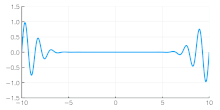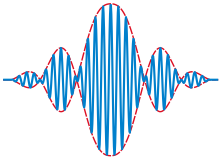
A | B | C | D | E | F | G | H | CH | I | J | K | L | M | N | O | P | Q | R | S | T | U | V | W | X | Y | Z | 0 | 1 | 2 | 3 | 4 | 5 | 6 | 7 | 8 | 9



The group velocity of a wave is the velocity with which the overall envelope shape of the wave's amplitudes—known as the modulation or envelope of the wave—propagates through space.
For example, if a stone is thrown into the middle of a very still pond, a circular pattern of waves with a quiescent center appears in the water, also known as a capillary wave. The expanding ring of waves is the wave group or wave packet, within which one can discern individual waves that travel faster than the group as a whole. The amplitudes of the individual waves grow as they emerge from the trailing edge of the group and diminish as they approach the leading edge of the group.
History
The idea of a group velocity distinct from a wave's phase velocity was first proposed by W.R. Hamilton in 1839, and the first full treatment was by Rayleigh in his "Theory of Sound" in 1877.[2]
Definition and interpretation

The group velocity vg is defined by the equation:[3][4][5][6]
where ω is the wave's angular frequency (usually expressed in radians per second), and k is the angular wavenumber (usually expressed in radians per meter). The phase velocity is: vp = ω/k.
The function ω(k), which gives ω as a function of k, is known as the dispersion relation.
- If ω is directly proportional to k, then the group velocity is exactly equal to the phase velocity. A wave of any shape will travel undistorted at this velocity.
- If ω is a linear function of k, but not directly proportional (ω = ak + b), then the group velocity and phase velocity are different. The envelope of a wave packet (see figure on right) will travel at the group velocity, while the individual peaks and troughs within the envelope will move at the phase velocity.
- If ω is not a linear function of k, the envelope of a wave packet will become distorted as it travels. Since a wave packet contains a range of different frequencies (and hence different values of k), the group velocity ∂ω/∂k will be different for different values of k. Therefore, the envelope does not move at a single velocity, but its wavenumber components (k) move at different velocities, distorting the envelope. If the wavepacket has a narrow range of frequencies, and ω(k) is approximately linear over that narrow range, the pulse distortion will be small, in relation to the small nonlinearity. See further discussion below. For example, for deep water gravity waves, , and hence vg = vp /2. This underlies the Kelvin wake pattern for the bow wave of all ships and swimming objects. Regardless of how fast they are moving, as long as their velocity is constant, on each side the wake forms an angle of 19.47° = arcsin(1/3) with the line of travel.[7]
Derivation
One derivation of the formula for group velocity is as follows.[8][9]
Consider a wave packet as a function of position x and time t: α(x,t).
Let A(k) be its Fourier transform at time t = 0,
By the superposition principle, the wavepacket at any time t is
where ω is implicitly a function of k.
Assume that the wave packet α is almost monochromatic, so that A(k) is sharply peaked around a central wavenumber k0.
Then, linearization gives
where
- and
(see next section for discussion of this step). Then, after some algebra,
There are two factors in this expression. The first factor, , describes a perfect monochromatic wave with wavevector k0, with peaks and troughs moving at the phase velocity within the envelope of the wavepacket.
The other factor,
- ,
gives the envelope of the wavepacket. This envelope function depends on position and time only through the combination .
Therefore, the envelope of the wavepacket travels at velocity
which explains the group velocity formula.
Other expressions
For light, the refractive index n, vacuum wavelength λ0, and wavelength in the medium λ, are related by
with vp = ω/k the phase velocity.
The group velocity, therefore, can be calculated by any of the following formulas,
Antropológia
Aplikované vedy
Bibliometria
Dejiny vedy
Encyklopédie
Filozofia vedy
Forenzné vedy
Humanitné vedy
Knižničná veda
Kryogenika
Kryptológia
Kulturológia
Literárna veda
Medzidisciplinárne oblasti
Metódy kvantitatívnej analýzy
Metavedy
Metodika
Text je dostupný za podmienok Creative
Commons Attribution/Share-Alike License 3.0 Unported; prípadne za ďalších
podmienok.
Podrobnejšie informácie nájdete na stránke Podmienky
použitia.
www.astronomia.sk | www.biologia.sk | www.botanika.sk | www.dejiny.sk | www.economy.sk | www.elektrotechnika.sk | www.estetika.sk | www.farmakologia.sk | www.filozofia.sk | Fyzika | www.futurologia.sk | www.genetika.sk | www.chemia.sk | www.lingvistika.sk | www.politologia.sk | www.psychologia.sk | www.sexuologia.sk | www.sociologia.sk | www.veda.sk I www.zoologia.sk














